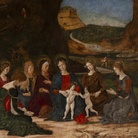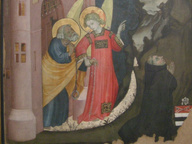Alessandro Scarabello. The Garden of Phersu

© The Gallery Apart, Rome | Alessandro Scarabello, The Womb, 2015, cm179,5 x 140, oil on canvas
From 12 Maggio 2016 to 31 Luglio 2016
Rome
Place: The Gallery Apart
Address: via Francesco Negri 43
Telefono per informazioni: +39 06 68809863
E-Mail info: info@thegalleryapart.it
Official site: http://www.thegalleryapart.it
The Gallery Apart is proud to present The Garden of Phersu, the latest collection of works that Italian artist Alessandro Scarabello produced after gaining an MFA at the Royal Academy of Fine Arts-KASK in Ghent (B) and his relocation in Brussels. An extensive and intensive research that materializes in a series of large and medium-scale paintings and drawings on paper that show not only an artistic evolution but also the continuity with the artist’s previous works, which The Gallery Apart has been following since its very beginning.
The exhibition’s title chosen by Scarabello is a reference that is halfway between history and myth as it recalls the enigmatic figure of Phersu, a character reproduced on the frescoes of Etruscan tombs at Tarquinia (Italy), characterized by physiognomic and proxemic elements that fully render the characteristic of a mask, as also corroborated by the name on the inscriptions - therefore meaning “mask”, corresponding to the Latin “persona”. In the artworks on show, which the artist considers the affirmation of a lexicon consisting of both technical and theoretical elements acquired and absorbed over the last two years, the focus on the body and corporality is mediated through the use of an object-simulacrum, the scarecrow, which imitates the same postures and shapes as those of the human body, but without the limits imposed by reality and verisimilitude, and rather leaving room for deformation and surreality, the mask indeed. In the artist’s imagery, both Phersu (who is the ferryman to the Underworld) and the scarecrow represent figures poised between neurotic laughter and horror, like several other characters from the Commedia dell’Arte and the Italian cultural tradition.
The work by Scarabello has always been related to the drama, the mask, the staging, but today his research is focused on the more specific field of identity. Like in a negative photographic image, the
artist tackles it from the point of view of the depersonalisation, in an attempt to clarify how people, in contact with mass culture, with the “show” and the constant proliferation of images, change themselves in order to better adapt to reality so as to effectively pursue strategies, sometimes even instinctive and unconscious, aimed at overcoming the atavistic fear of death. Strategies that sometimes have grotesque connotations, highlighting how men’s reaction to contemporaneity may be awkward, just like their behaviour. In Scarabello’s artworks, the figures’ movements become radicalised due to the lack of verbal communication to then become completely motionless because of an excess of balance.
The image simulacrum created by Scarabello is often set in environments characterized by a dense vegetation. It is a constant element that the artist relates directly with the way Westerners perceive the idea of escape, of distraction, of entertainment. The stereotyped image of landscapes and of nature, and therefore the desire for “exoticism”, for holidays in tropical destinations, comes directly from the (sad) legacy of Western settlers and by their unidirectional perception of the “new world”.
The new collection of works is the result of a long phase of in-depth study and reflection on the alternation of empty and full, dwelling on the experimentation of tridimensionality through the breaking of the canvas and the overlaying of pieces of paintings, influenced by a strong attraction to abstract art which manifested itself with an impulse that pushed him towards the exasperation of gestures and shapes.
All this contributed to the creation of the substratum upon which Scarabello has developed his determination toexperiment with colour as well as to tackle the canvas with a greater expressiveness. In the paintings on show the figurative element is given back through an abstract reading of the detail and the notion of “emptiness” materializes itself through the way of painting rather than through the manipulation of the support.
Vernissage: 12 May 2016, 6.00 pm
SCARICA IL COMUNICATO IN PDF
COMMENTI

-
 Dal 20 dicembre 2024 al 04 maggio 2025
Fermo | Palazzo dei Priori
Dal 20 dicembre 2024 al 04 maggio 2025
Fermo | Palazzo dei Priori
-
 Dal 20 dicembre 2024 al 04 maggio 2024
Gorizia | Palazzo Attems Petzenstein
Dal 20 dicembre 2024 al 04 maggio 2024
Gorizia | Palazzo Attems Petzenstein
-
 Dal 18 dicembre 2024 al 18 dicembre 2024
Venezia | Museo Correr
Dal 18 dicembre 2024 al 18 dicembre 2024
Venezia | Museo Correr
-
 Dal 14 dicembre 2024 al 02 marzo 2025
Palermo | Palazzo Abatellis
Dal 14 dicembre 2024 al 02 marzo 2025
Palermo | Palazzo Abatellis
-
 Dal 12 dicembre 2024 al 23 febbraio 2025
Roma | Palazzo Altemps
Dal 12 dicembre 2024 al 23 febbraio 2025
Roma | Palazzo Altemps
-
 Dal 13 dicembre 2024 al 31 agosto 2025
Roma | Museo dell'Ara Pacis
Dal 13 dicembre 2024 al 31 agosto 2025
Roma | Museo dell'Ara Pacis


